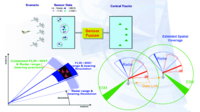
Photo from wikipedia
RNA 5-hydroxymethylcytosine (5hmC) is a kind of RNA modification, which is related to the life activities of many organisms. Studying its distribution is very important to reveal its biological function.… Click to show full abstract
RNA 5-hydroxymethylcytosine (5hmC) is a kind of RNA modification, which is related to the life activities of many organisms. Studying its distribution is very important to reveal its biological function. Previously, high-throughput sequencing was used to identify 5hmC, but it is expensive and inefficient. Therefore, machine learning is used to identify 5hmC sites. Here, we design a model called R5hmCFDV, which is mainly divided into feature representation, feature fusion and classification. (i) Pseudo dinucleotide composition, dinucleotide binary profile and frequency, natural vector and physicochemical property are used to extract features from four aspects: nucleotide composition, coding, natural language and physical and chemical properties. (ii) To strengthen the relevance of features, we construct a novel feature fusion method. Firstly, the attention mechanism is employed to process four single features, stitch them together and feed them to the convolution layer. After that, the output data are processed by BiGRU and BiLSTM, respectively. Finally, the features of these two parts are fused by the multiply function. (iii) We design the deep voting algorithm for classification by imitating the soft voting mechanism in the Python package. The base classifiers contain deep neural network (DNN), convolutional neural network (CNN) and improved gated recurrent unit (GRU). And then using the principle of soft voting, the corresponding weights are assigned to the predicted probabilities of the three classifiers. The predicted probability values are multiplied by the corresponding weights and then summed to obtain the final prediction results. We use 10-fold cross-validation to evaluate the model, and the evaluation indicators are significantly improved. The prediction accuracy of the two datasets is as high as 95.41% and 93.50%, respectively. It demonstrates the stronger competitiveness and generalization performance of our model. In addition, all datasets and source codes can be found at https://github.com/HongyanShi026/R5hmCFDV.
Journal Title: Briefings in bioinformatics
Year Published: 2022
Link to full text (if available)
Share on Social Media: Sign Up to like & get
recommendations!